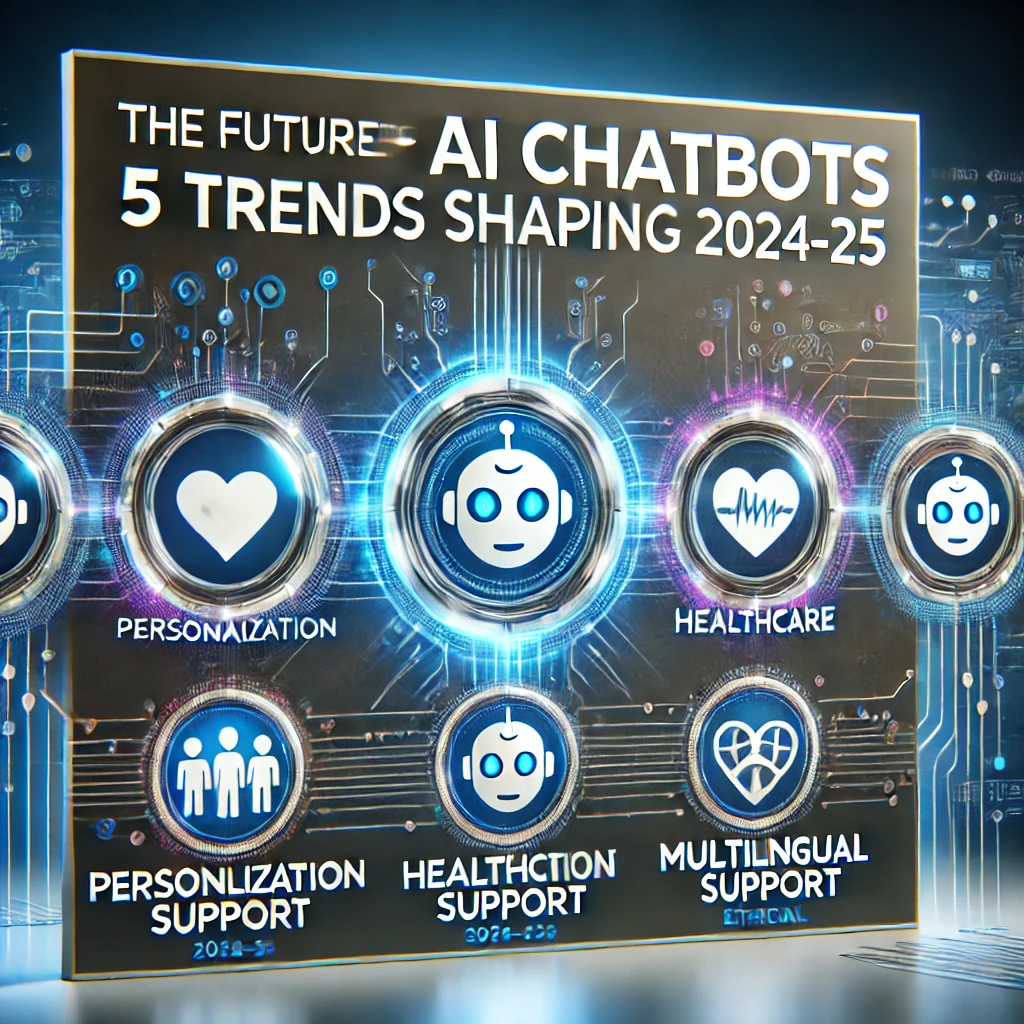AI chatbots have transformed from basic, rule-based systems into complex tools capable of simulating conversations that feel increasingly human. They are now becoming an essential part of industries such as customer service, healthcare, education, and even personal interactions. As technology continues to evolve, chatbots will only grow more sophisticated, shaping our daily lives in profound ways. From 2024 to 2025, several trends will define the future of AI chatbots, leading to more seamless and natural interactions.
In this post, we’ll examine five key trends that are set to shape the next generation of AI chatbots, with a focus on their increasing importance in various sectors.
1. Personalization: Chatbots That Know You Better
One of the biggest trends we’re seeing is the move toward more personalized interactions. Chatbots are no longer limit to one-size-fits-all responses. Instead, they now have the ability to offer highly individualized recommendations and interactions based on user data such as previous conversations, preferences, and behaviors. This type of interaction feels more human, with chatbots learning about users over time and adjusting their responses accordingly.
For example, in e-commerce, chatbots are becoming virtual shopping assistants. They can suggest products based on a user’s purchase history or browsing patterns, making the shopping experience more intuitive. In the same way, chatbots are being use in media and entertainment to recommend movies, music, or games that align with a user’s taste.
Similarly, these personalize responses are now being integrate into customer service systems. Instead of handling each inquiry in isolation, chatbots remember previous interactions, offering solutions that are more relevant and helpful. This shift allows companies to provide a higher level of service, all while reducing the need for human intervention in repetitive tasks.
2. Healthcare: AI Chatbots as Virtual Assistants
Healthcare is another area where AI chatbots are making a substantial impact. They are being integrate into health systems to provide immediate assistance to patients, answering questions, scheduling appointments, and even offering medical advice based on a predefine set of algorithms. While they’re not a replacement for medical professionals, chatbots provide a first point of contact that helps manage less urgent queries or guide patients on when to seek professional care.
In particular, mental health applications have begun using AI chatbots to offer support to users who may be struggling with stress, anxiety, or depression. These chatbots can guide users through exercises like mindfulness and cognitive behavioral techniques, or simply offer a compassionate ear. This is especially helpful in cases where individuals may be hesitant to seek traditional therapy or when access to professionals is limited.
In the future, chatbots are expect to assist in managing chronic diseases, reminding patients to take medication, monitor symptoms, and offer 24/7 support. They will not only enhance patient care but also help to alleviate the burden on healthcare systems by automating routine tasks.
3. Voice Interaction: Hands-Free Communication
As AI technology advances, voice-activated chatbots are becoming more prevalent. Typing out responses is slowly being replace by speaking directly to chatbots, which can now understand and respond to voice commands. Voice interaction is particularly useful for tasks like setting reminders, asking for information, or controlling smart devices without needing to touch a screen.
Voice-enabled chatbots are becoming integrated into home automation systems, helping users manage their schedules, control home appliances, and even access entertainment services. For example, a user might ask their voice assistant to play a specific song, set the temperature in their home, or book a table at a restaurant, all without lifting a finger.
Additionally, voice interaction offers significant accessibility benefits. People with disabilities or elderly individuals who may struggle with traditional user interfaces can now interact with technology more easily. In comparison to text-based chatbots, voice assistants offer a more intuitive and faster experience.
4. Multilingual Chatbots: Expanding Global Reach
As businesses become more global, there’s a growing need for chatbots that can communicate in multiple languages. AI chatbots are being design to support a variety of languages, helping to break down language barriers and provide a smoother user experience for international customers. By 2024-25, we’ll see even more advanced multilingual chatbots capable of switching languages seamlessly and handling complex, culturally-specific conversations.
For companies operating across different countries, multilingual chatbots offer a significant advantage. They allow businesses to communicate with customers in their native language, improving customer satisfaction and reducing misunderstandings. Not only does this improve customer support, but it also helps businesses expand their reach without needing to hire large multilingual teams.
What’s exciting about this trend is that chatbots are becoming increasingly aware of cultural nuances, ensuring that responses are appropriate and respectful in different contexts. This development is particularly important for companies that want to maintain a positive global reputation.
5. Chatbots in Personal Relationships: Navigating New Boundaries
AI chatbots are also entering more personal areas of our lives, particularly in the way we form and maintain relationships. These bots are being used in some cases to simulate companionship, providing individuals with emotional support or acting as a form of virtual interaction when human contact may be lacking. Interestingly, there’s a rising trend in AI sexting, where users engage in flirtatious or intimate conversations with chatbots. While some might see this as a way to explore or manage long-distance relationships, it also brings up important ethical questions about privacy and emotional boundaries when interacting with AI.
This trend is somewhat controversial, as it challenges traditional views on relationships and raises questions about the boundaries of AI involvement in personal matters. While some see this development as an extension of technology’s role in modern life, others worry about the psychological and societal impacts of relying on AI for emotional connections.
Nevertheless, AI chatbots continue to play a role in offering companionship, especially for those experiencing loneliness or social isolation. As these bots become more sophisticated in their understanding of human emotions, they may offer support in new and unexpected ways, all while sparking debates about the ethical implications of AI in personal spaces.
Challenges and Ethical Considerations
Even though AI chatbots are becoming more capable, they come with challenges and ethical concerns. One of the most pressing issues is data privacy. As chatbots collect personal data to provide more personalized services, how can we ensure that this data is being handle responsibly? Users need to feel confident that their information is protect, especially when dealing with sensitive topics like health or personal relationships.
Another challenge lies in balancing the automation of tasks with the potential loss of jobs. As chatbots take over more roles in customer service, healthcare, and other industries, there’s growing concern about how human jobs will be affect. While chatbots can handle repetitive tasks efficiently, human workers may still be need for more complex, nuanced tasks that require empathy and understanding.
Finally, ethical considerations regarding AI’s role in personal interactions, whether through companionship or other forms of engagement, are becoming increasingly important. We need to think carefully about the psychological effects of AI chatbots as they become more deeply integrated into our lives.
Conclusion
The future of AI chatbots is full of potential, and the trends shaping 2024-25 will push these tools to new levels of functionality and intelligence. As they become more personalized, integrated into healthcare. Capable of understanding multiple languages, chatbots are set to transform industries and improve user experiences.
However, with these advancements come important ethical questions that need to be addressed. As AI chatbots become more involve in personal interactions and data-driven services, we must ensure that they are developed responsibly, with privacy and ethical considerations at the forefront. The next few years will be critical in determining the balance between innovation and responsible AI use, as chatbots become an even more integral part of our world.






More Stories
Why Business Needs Mobile App Development Services in USA?
Remote Full Stack Developers in Dublin
How Azure Cloud is the Future of AI & ML